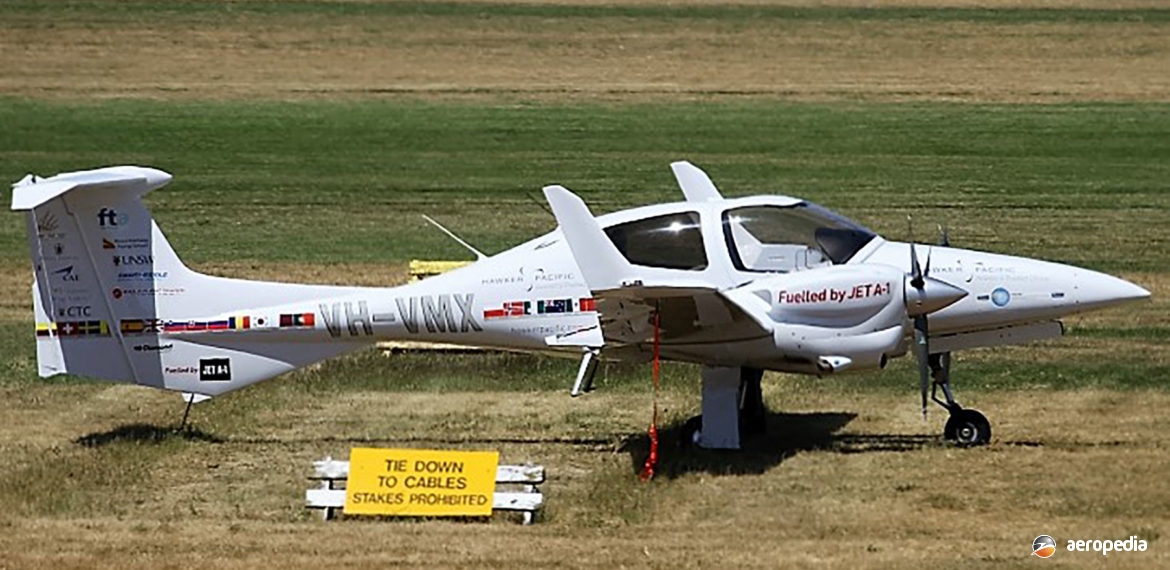Photograph:
Diamond DA-42-V1 VH-VMX (c/n 42.N139) at Camden, NSW in December 2014 (David C Eyre)
Country of origin:
Canada
Description:
Four-seat business, executive and touring monoplane
Power Plant:
Two 125 kw (168 hp) Austro Engine AE300 2000 cc turbocharged, intercooled, common-rail, injected diesel engines
Specifications:
- Wingspan: 13.55 m (44 ft 4 in)
- Length: 8.56 m (28 ft 1 in)
- Height: 2.49 m (8 ft 2 in)
- Wing area: 16.46 m² (177.2 sq ft)
- Max speed: 357 km/h (222 mph)
- Cruising speed at 5,486 m (18,000 ft) at 75% power: 333 km/h (207 mph)
- Stalling speed full flaps: 113 km/h (70 mph)
- Max operating altitude: 5,486 m (18,000 ft)
- Single-engine service ceiling: 5,486 m (18,000 ft)
- Max demonstrated crosswind speed: 46 km/h (29 mph)
- Range at 75% power with 45 mins reserve: 1,667 km (1,036 miles)
- Range at 60% power with 45 mins reserve: 2,251 km (1,398 miles)
- Take-off distance at 1,999 kg (4,407 lb): 424 m (1,390 ft)
- Landing distance ground roll: 340 m (1,115 ft)
- Rate of climb at sea level: 427 m/min (1,400 ft/min)
- Useful load: 590 kg (1,301 lb)
- Loaded weight: 1,999 kg (4,407 lb)
History:
The genesis of the Diamond DA-42 commenced in 1981 when the then Austrian-based company, Diamond Aircraft Industries, produced a series of gliders and continued over the years to produce the DA-20, DA-40 and DA-42 series, these being very distinctive aircraft in having long high-aspect ratio wings, winglets, and a tapered fuselage. The DA-42-V1 was developed to replace the previous variant with the ill-fated Thielert engines, also produced in Austria, so the Company could offer the design with a newer diesel engine as well as the normally aspirated model with the Lycoming O-360 series of engines.
Development of diesel engines in recent years proceeded apace and Diamond offered the initial series of the DA-42 with the Thielert unit. However, problems with this engine and its production forced the Company to offer the Lycoming engine as an interim measure pending availability of a new diesel engine.
The DA-42-V1 became available in 2014 and has become popular, the extra torque of the Austro Engine AE-300 engine providing a higher-pitch propeller which has provided greater thrust and performance.
The fuselage was built in two halves, bonded together longitudinally, the vertical stabiliser being part of the assembly and the T-tail being then attached separately. The wings were vacuum moulded and built in two sections, joined at the fuselage and bonded together. The fuel tanks were installed in removable aluminium cells between the spars. The trailing link retractable undercarriage was operated hydraulically and an electrical pump drove the actuators. With the new model there were a number of aerodynamic improvements, including re-designed cowlings, wing fairings, flush-head screws, and new propellers, with a reduction in weight, with decreased drag, giving improved performance.
First of the type seen in this area was registered as VH-VMX (c/n 42.N139) to the University of New South Wales at Bankstown, NSW on 7 October 2014.

